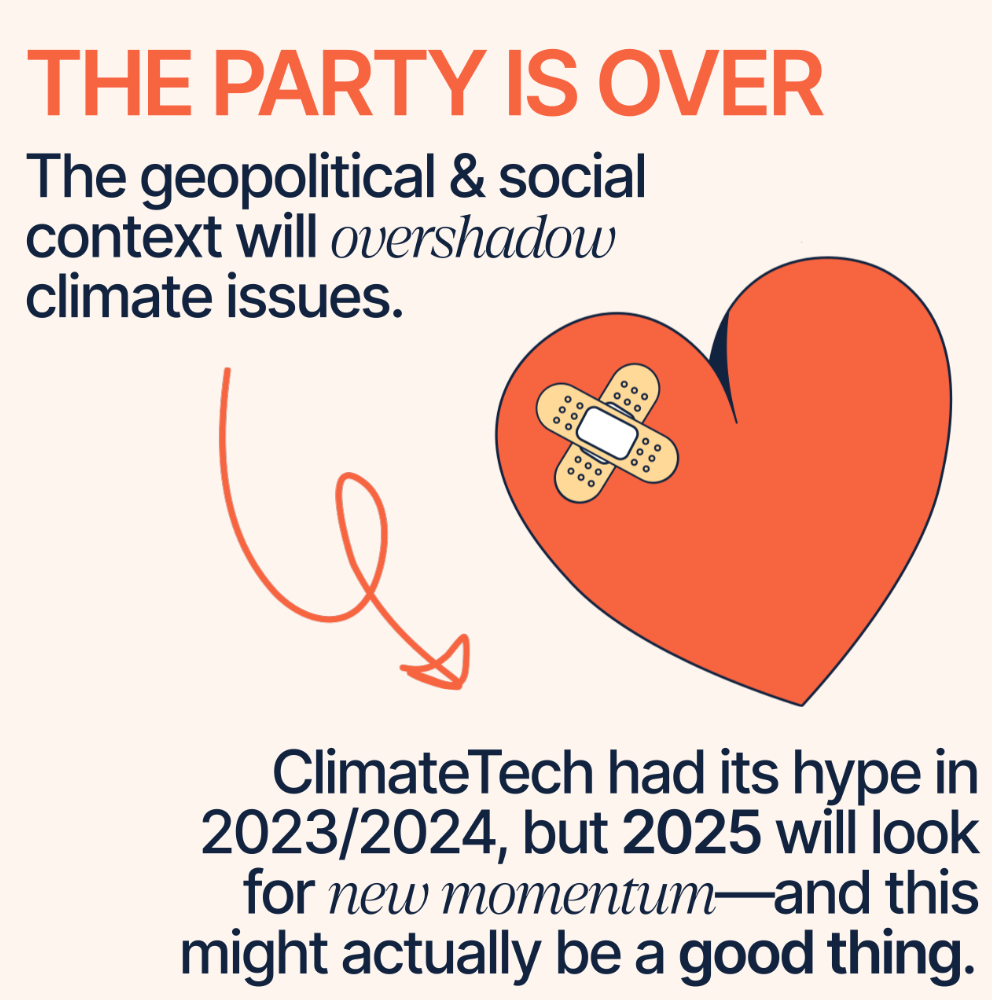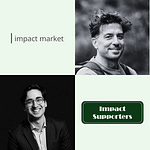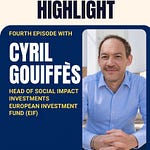Disclaimer from August Solliv: The views expressed are solely my own i.e. it’s my Sunday fun work 😉
Key insights:
Interview with Eric Gossart, Partner at Serena’s impact fund Racine^2
Racine^2 has unique criteria as part of their impact methodology: they take into account the accessibility and affordability of all solutions (also for climatetech) 🌍
Eric recommends launching an impact VC fund as a collaboration between a VC and a non-profit if you are already an established VC household name - but less so if you are an emerging manager 🤝 In general, mixing DNA is always a good idea, but it does not necessarily have to go through a partnership
Racine^2 is an impact-first VC fund. Some of the impact returns of the social deals increase the overall impact performance of the fund. Some of the financial returns of the environmental deals increase the overall financial performance of the fund ⚖️
Greetings to 3k+ Impact Supporters! 🌍 This is August Solliv writing 👋 Let’s dive into a specific impact VC model, namely a partnership between a traditional VC and a non-profit (≈7 mins reading time):
Rationale for investing in climate 🔥
Partnering with a non-profit 🏢
Racine^2’s impact methodology 📊
Choosing impact KPIs 🎯
Balancing impact and financial returns 💰
Tips to generalist and impact VC investors 🧠
Meet Eric Gossart 👋
Eric is a father of one and a partner at Serena. He has a business background. He was first a VC analyst at CapHorn Invest and then worked at the LBO fund Galina Capital. Eric then joined Serena over 10 years ago. Eric started at Serena as a SW investor but transitioned into becoming an impact investor in 2022 with the launch of Racine^2, a French impact VC fund investing in climate, education, and healthtech 🌱 Eric made the transition into impact to increase the alignment between his work and values.
Meet Racine^2 and Serena 💼
Serena is a French VC firm based in Paris 🇫🇷 They have been software investors since 2008 and have raised approx. €1bn since then. They have four funds that they invest actively out of spanning from generalist to AI to impact 🤖 Serena is especially characterized by having a strong network of operating partners with focuses on e.g. HR, marketing, and product.
Since 2018, Serena has transitioned to focus increasingly on sustainability. They have backed for example Electra in EV-charging, Jimmy Energi in micro-nuclear, and Accenta in geothermal energy - and they have launched Racine^2, an impact fund with €85m AUM.
Rationale for investing in climate 🔥
To Eric, Serena’s transition into investing in impact was natural as they have always adapted their model to invest in new transitions 🔄 For example, they raised an A.I. fund in 2015 when that transition started. Eric sees climate as a big transition, and, therefore, a big VC opportunity 🌿
Partnering with a non-profit 🏢
[Racine^2 has a unique model in the impact VC space. Eric and his team partnered with an NGO to build impact expertise. I asked Eric about it]
Racine^2 is a partnership between Serena and Makesense. Makesense is a non-profit creating tools and programs to enable people to take action and build an inclusive and sustainable society 🌍 The partnership started as MGEN, a French insurer, launched a tender where bidders could present a model for building and managing an impact fund, and Serena and Makesense won together. They believe they won the tender as they bring both the ‘gold standard’ for VC investments and the ‘gold standard‘ for impact work 🏆
It didn’t make sense for either Serena or Makesense to launch on their own - Serena would have had to build sustainability skills and build an impact brand - whereas Makesense would have had to learn from scratch how to manage a €100m fund (which is very different than managing an €8million fund, which Makesense had previously raised).
Eric would also advise emerging emerging managers to work with a non-profit to build an impact VC as he believes that there is a lot of learning to be had from mixing the different DNAs of the impact and VC worlds 🌉Moreover, building an impact VC as a partnership between a VC and a non-profit supercharges the building phase as you are not building from scratch 📈
Racine^2’s impact methodology 📊
Racine^2 works with the impact methodology designed by Makesense. It builds on 6 pillars:
Intensity of the impact (is the solution targeting a big enough market?)
Additionality (is the product different from competitors?)
Impact model (is the impact model proven and solving a real issue?)
Accessibility and Affordability (is the product affordable and accessible? i.e. not too expensive)
Consistency of values (is the company best-in-class on impact)
Total impact (does the solution have a negative impact as well as its positive impact - and what is the total effect?)
Accessibility and Affordability are the most untraditional pillars in an impact VC context. Eric defines affordability as making sure that people in low-income groups can buy the product. Accessibility is to create business models where rich clients could partillay subsidize partly the products for low-income clients.
Accessibility and Affordability really stand out in healthtech according to Eric 💊 A lot of companies are addressing diseases, but where the price of the solution is too expensive. All healthtech solutions have a positive impact per definition as they help increase the length of life or increase the quality of life of patients, but you need accessibility and affordability to increase the impact 🌎
(Sorry for the French graph, but it shows at what stages in the investment process Racine^2 works with impact and what they do)
Source: Racine^2, 2023
Choosing impact KPIs 🎯
Eric says that at Racine^2, they choose impact KPIs that are not directly linked to revenue - even though it’s not easy 📉 Eric builds his argument on an example: “Imagine that I am the CEO of Tesla, so I am selling EVs. We could say that the more I sell EVs, the more I contribute to the decarbonization of the transportation industry. But actually, I'm selling EVs in China, where the electricity is very carbon intensive ⚡ And the more I sell EVs, the more batteries I need, so the more rare metals I need - and I have a bad impact on deforestation 🌲” So it’s not necessarily the right to choose an impact KPI linked to a start-ups revenue.
Eric, however, also says that he invests at Seed stage so it can be hard to define the right impact KPIs from the start as the company might pivot. Therefore, Racine^2 has an option to update and change their impact KPIs all throughout the lifetime of an investment.
Balancing impact and financial returns 💰
Eric argues that at Racine^2 they are balancing impact and financial returns ⚖️ He believes that socialtech companies create sub-market rate returns because of the business model complexity.
At Racine^2 some of the financial returns of the environmental deals, therefore, subsidize the social deals. And some of the impact returns of the social deals increase the overall impact performance of the fund. Therefore, you can characterize the fund as being impact-first.
Tips to generalist and impact VC investors 🧠
For generalists: Don’t be discouraged if you are just at the beginning of transitioning into impact 🌱 It’s not easy to be in impact because the traditional financial sector sees you nearly as a non-profit - so have to be part of proving them wrong.
For impact VCs, I think it is our responsibility to also educate founders on what we are looking for in impact companies 🎓 Eric sees many impact VCs reject companies because their impact is not big enough - he would then suggest to be very specific when declining an opportunity to help founders to better understand and assess their impact.
Eric also says that a basic test for a start-up to find out if they can be regarded as an impact company is to ask yourself 1. “am I transitioning my industry into something more sustainable?”, and 2. “can I define impact KPIs for my business and we progress on them?”, then you will know.
And to round it off, here are some of Racine^2’s predictions for 2025 in the impact VC space:
Source: Gossart, 2025
Thanks for reading this week’s newsletter! Let me know what you think of this article and who else I should interview in this series - either in the comments section or in my DMs. Please subscribe to stay updated on articles about everything related to impact VC - and share with friends and colleagues. See you next week for another issue! 👋
~ August
(As these photos show, I’m an actual human writing this newsletter. Not AI. 🤖)
Links to articles/data mentioned:
















Share this post